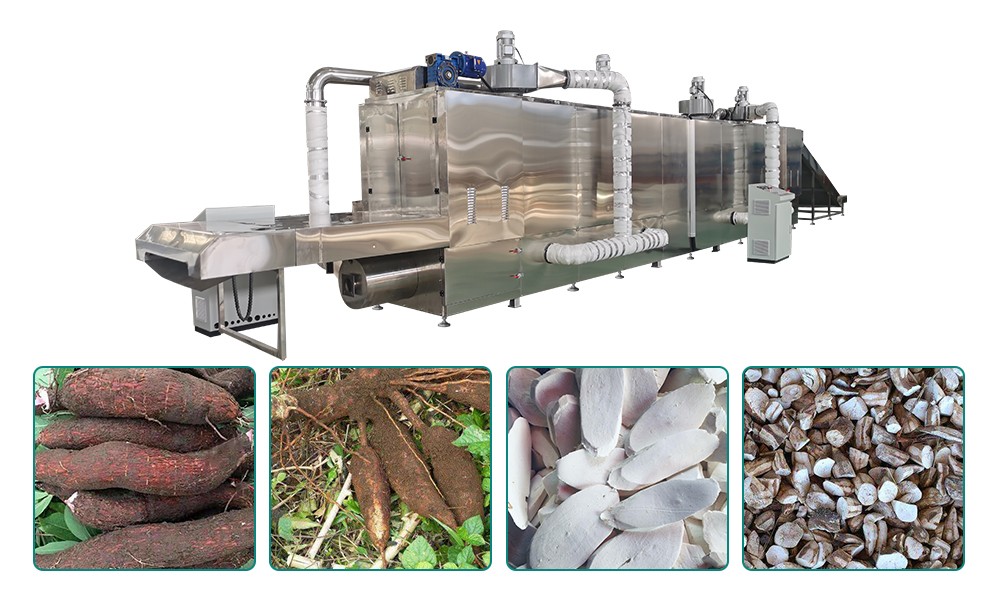Cassava is a woody shrub of the spurge family that are widely cultivated in tropical and subtropical regions of the world like in Africa, Asia, and America. Every year, the world is manufacturing around 250 million tonnes of cassava. Completely different types of cassava are usually classified into sweet cassava and bitter cassava, they contain different types of cyanogenetic glycosides. Cassava also contains rich carbohydrates that are a staple food in the developing countries, for instance, people directly boil cassava to eat or bake it into cassava cake. In medical science, cassava contains a low glycemic index and is gluten-free, that is good for diabetics and useful for celiac patients severally. In the industrial production, cassava is typically processed into cassava starch (tapioca), snacks (chips), pellets for animal feeds.

Cassava Dehydration by Hot Air Drying Oven
Deterioration begins in the fresh cassava among 2 or 3 days once harvesting. Thus, cassava is typically sold as a processed product, particularly dehydration formed cassava. Dehydration will prolong cassava’s preservation time and the main dried products are usually in powders, chips and pellets forms.
Usages of Dried Cassava Products
During post-harvest, except directly consumption and freezing, cassava is generally through drying for preservation and sold in international markets. African countries manufacture more than half of the world’s cassava, at 118 million MT. However, most African countries consume the majority of the cassava they manufacture as a “non-traded commodity”. Therefore, the top one exporter of dried cassava is Thailand in Asia, followed by Vietnam, Indonesia and so on. The export markets of dried cassava are primarily in Europe, North America, and Asia. Dried cassava markets usually have 3 varieties: human food like cassava starch and snacks, industrial use like industrial starch and its derivatives, animal feeds like cassava pellets.
In industry, native starch can also be processed into modified starch and utilized in industrial materials, that are utilized in numerous markets, like paper industry, textile industry like clothing finishing and printing, construction materials, medicines, etc. totally different from native starch, modified starches are made by manipulating a native starch’s intrinsic physical, chemical or microbiological processes to fulfill users’ needs for their specific application. For example, cassava starch would need to be modified to produce bio-degradable plastics or any application that requires properties associated with low amylase content. In general, North-America dominates the global modified starch market and now is looking for other feasible option except corn starch, and with a growing interest of the food industry with low cost and high-performance ingredients of starch. This, coupled with technology improvements, has fueled the demand for cassava starch. Diversification within the cassava industry is inevitable in global, modified cassava starch will penetrate into the traditional cornstarch markets, and as more cassava starch firms will compete with multinational companies. For example, in a developing country such as Brazil, the production of modified starch now constitutes 30 percent of cassava starch, which is 90000 tonnes per year. In Brazil, cassava starch competes directly with cornstarch. As data has proven that modified cassava starches have presented some properties related to cornstarch which can be substitutes of traditional cornstarch. In some markets such as paper and textile industries in Brazil, modified cassava starches have a large market share now, and corn companies lost some of their positions.
In the future, dried cassava still has markets.
(1) For example, in food processing, it will be more used in starch manufacture especially the improved technology of more stabilized modified starch.
(2)In animal feeding, the demand for animal pellets will be higher than chips forms since the former saves 30% of the storage space.
(3)In food industrial, dried cassava will be processed with protein-food such as soybeans for a balanced nutrition supply.
Here’s a glimpse of KERONE team in action, creating the perfect hot air dryer and dehydrator systems to meet your industrial needs.
